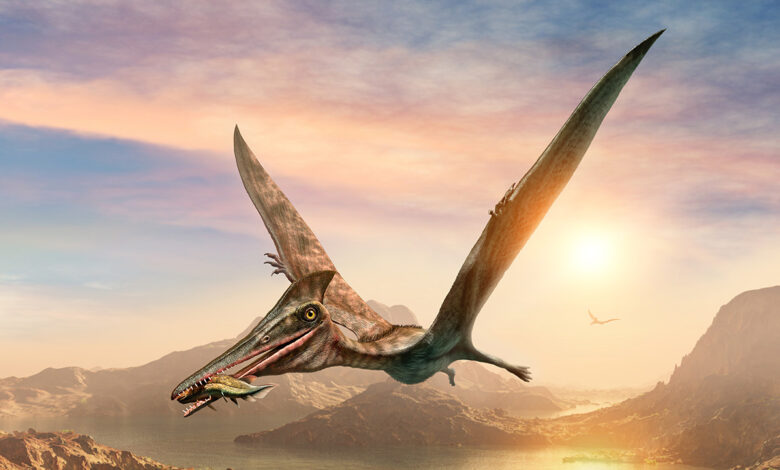Australian researchers discover country’s largest flying reptile

[ad_1]
A team of Australian researchers has discovered the country’s largest flying reptile.
The fearsome, long-necked pterosaur had a wingspan measuring seven meters in length and what the team calls a “spear mouth.”
INDONESIA BUILDING ITS OWN ‘JURASSIC PARK’ DESPITE WARNINGS
According to a paper published in the Journal of Vertebrate Paleontology, Thapunngaka shawi was located at the geological Toolebuc Formation near Richmond in North West Queensland.
The authors noted that the Toolebuc formation shows the period when shallow seas covered around 60% of Australia.
In June of 2011, local fossicker Len Shaw uncovered the rostral portion of the new anhanguerian pterosaur’s crested mandible at a site called “water pond.”
“This is a very exciting find because pterosaurs are extremely rare, not just in Australia but worldwide. It was found 10 years ago by a gentleman called Len Shaw. So, Len used to work for Twin Council and he would be one of the front-end loader drivers. On his lunch break, he’d essentially fill up the bucket of the front-end loader with water and then sort of gently tip it onto a slopey area of the quarry. And, one day he did that and lo and behold the teeth sockets were staring back at him,” University of Queensland Ph.D. candidate and Co-Author Tim Richards explained in a Monday video detailing the find. “And, he knew he was onto something. And, um, he called over to the curator at the time of Kronosaurus Korner, Paul Stumkat, and they excavated it. And, that’s it. That’s the story of our pterosaur.”
In a University of Queensland article, Richards said their pterosaur was “the closest thing [they[ have to a real life dragon,” pointing out that the skull alone would have been more than one meter long and containing 40 teeth used to catch food in what was once the Eromanga Sea.
The creature’s bones were thin-walled and relatively hollow.
The paper notes that pterosaur fossils are “exceptionally rare” down under and that fewer than 20 specimens had been described since the discovery of the continent’s first pterosaur around 40 years ago.
BEFORE AN ASTEROID WIPED THEM OUT, DINOSAURS WERE ALREADY IN DECLINE: STUDY
“The Lower Cretaceous (upper Albian) Toolebuc Formation of North West Queensland is the most productive horizon for Australian pterosaurs,” Richards and fellow author Dr. Steven Salisbury and Stumkat wrote in their abstract.
The group said their pterosaur had features that “indicate an affinity with Anhangueridae,” a known group of toothy pterosaurs and that their findings were “consistent with their reported cosmopolitan distribution during this period.”
“Thapunngaka shawi can be distinguished from other anhanguerids through the possession of a mandible with a smooth dorsal surface medially and uniquely sized alveoli that are positioned laterally along the jaw,” they wrote, noting that further phylogenetic analysis revealed a “close relationship” among all Australian anhanguerids and “points to an endemic Australian radiation within Anhangueridae.”
Salisbury told the university the genus was named in honor of the First Nations peoples of the Richmond area and incorporates words from the now-extinct language of the Wanamara Nation.
“Thapunngaka means ‘spear mouth’ in Wanamara, the language of the people on whose Country the fossils were found,” he wrote in a Monday tweet.
“The species name, shawi, honors the fossil’s discoverer Len Shaw, so the name means ‘Shaw’s spear mouth,'” he said.
CLICK HERE TO GET THE FOX NEWS APP
As the third-largest anhanguerian pterosaur known worldwide, the paper said that Thapunngaka shawi “provides further evidence for the existence of an increasingly diverse range of large crested pterosaurs in the Australian part of eastern Gondwana during the Cretaceous.”
“There’s always more to find,” Richards said. “There’s always more ground to scratch through.”
[ad_2]
Source link






